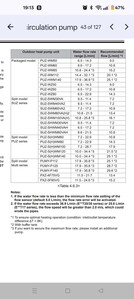Flow rate discrepancy between ASHP and manifold
Hello,
Firstly thanks for all the guidance on this forum, it has been a great help. I now get to the stage where I can't find the answer to my question on overall system design and would like some guidance.
Following best principles for efficiency I have tried to simplify my design to remove buffer tanks, manifold mixers etc. Running out as an open loop single zone.
My installers are going to put in an 11.2kw ecodan ASHP next week and connect to my 7 port manifold, with an average loop length of 80m going through 16mm pert al pert pipe at 150mm spacing in a 50mm cemfloor screed above 150mm Celotex.
No zoning, no pump/mixer on manifold, no buffer tank. Large 150l volumiser on the return. Large bore pipe size.
My problem is that the 11.2kw ecodan docs say it is most efficient at 32L/min flow, however my UFH wants probably around 17l/min flow. As I understand it If I run the UFH at 32l/min that is too much flow and could result in noise and reduced efficiency (delta T) because the water isn't in the pipes long enough to transfer it's heat to the screed.
How do I balance this isue being as I have removed the buffer tank and manifold pump from the design? I could drop the flow to the minimum the ASHP would take, 17l/min, but then the heat pump isn't working efficiently.
Thank you
If you have a UFH system that is a max design 6kW output (17lts flow) why are you installing a 11kw Ecodan?
Assuming the below is not far off either your loops need more flow to get up to 8.4Kw or you should reduce the ASHP to match closer to your design flow. Also the HP can capacity modulate down to the lower capacity but if you don't send the flow rate though or have a big enough emitter circuit it will not use the full capacity of the HP.
System Details:
7-port manifold → 7 loops
Average loop length: 80 m
Pipe type: 16 mm PERT-AL-PERT
Pipe spacing: 150 mm (0.15 m)
Screed: 50 mm Cemfloor (liquid screed, good conductivity)
Insulation: 150 mm Celotex (very good insulation, so minimal downward losses)
Step-by-Step Estimation:
1. Area Heated:
At 150 mm pipe spacing, each meter of pipe covers ~0.15 m².
Each loop (80 m) covers:
80 m×0.15 m=12 m280 \text{ m} \times 0.15 \text{ m} = 12 \text{ m}^280 m×0.15 m=12 m2
7 loops → total heated area:
7×12=84 m27 \times 12 = 84 \text{ m}^27×12=84 m2
2. Typical Heat Output per m²:
With 150 mm spacing in 50 mm screed and good insulation, you can typically expect 80–100 W/m² for standard flow temperatures (~45–50°C flow, ~35°C floor surface).
Using a conservative average of 90 W/m²:
84 m2×90 W/m2=7,560 W(7.56 kW)84 \text{ m}^2 \times 90 \text{ W/m}^2 = 7,560 \text{ W} \quad \text{(7.56 kW)}84 m2×90 W/m2=7,560 W(7.56 kW)
Estimated heat output: 7.5 – 8.4 kW
(depending on exact flow temperature, floor finish, and room air temperature)
AAC Group Ltd covering the Kent Area for design, supply and installation of ASHP systems, service and maintenance, diagnostics and repairs.
Professional installer. Book a one-to-one consultation for pre- and post-installation advice, troubleshooting and system optimisation.
Welcome to the forums.
Your approach to stripping out the inefficiencies (buffer, mixer, zones, etc.) and keeping the system as open loop as possible is solid. It’s encouraging to see more homeowners and installers heading down this path.
You’re also absolutely right to raise the point about flow rates and potential mismatches between what your heat pump “wants” and what your UFH can comfortably handle. It’s a common pinch point in these simplified systems.
The 11.2kW Ecodan does indeed state an optimal system flow rate of around 32 L/min for peak efficiency and that’s based on a delta-T of 5C. However, if your UFH is designed for a lower flow rate (say around 17–20 L/min), pushing 32 L/min through the loops could result in excessive velocity, noise and a very narrow delta T, which could reduce the system’s ability to transfer heat effectively into the slab.
This is where your volumiser can play a useful role because it increases the system’s volume and helps stabilise flow rates and temperatures. It won’t allow for different flow rates on the primary and secondary circuits like a buffer with hydraulic separation would, but it still gives your system a bit more breathing room.
If the installer has selected the correct primary circulation pump (and it’s controllable), you can tune the system to match what the UFH can handle (perhaps 24–26 L/min) to see if that delivers enough power and keeps the heat pump within its happy place, even if it’s a touch below its ideal.
Once the system is commissioned, logging flow rate, delta T and run times will be key. If you’re seeing very short cycle times, high return temps, or a rapidly closing delta T, then you might need to revisit flow balancing.
It's an interesting question though, and I'll ask my panel about it this Friday on the podcast.
As a general reference (for others reading this), typical recommended flow rates for common ASHP outputs are:
- 5 kW: ~14 L/min
- 7 kW: ~20 L/min
- 8 kW: ~23 L/min
- 12 kW: ~34 L/min
- 16 kW: ~46 L/min
Let us know how it goes after commissioning because it's always good to see real-world examples.
Get a copy of The Ultimate Guide to Heat Pumps
Subscribe and follow our YouTube channel!
Thanks. I'm installing the 11.2kw ecodan because that is what the install company calculated. I'm pretty sure that the full 11.2kw will only be needed to for a quicker domestic hot water cycle (300l DHW tank). I don't trust the heat loss calcs the installers have given me so an not sure exactly what loss my building will be, though for what it's worth they calculated 9kw heat loss for the building.
If I'm reading your reply correctly I could run the UFH system at a lower flow rate with the heat pump modulated down to 70% or so at max when it's supplying the UFH.
My next question then is... What is more efficient...
1) 11.2kw open loop with modulation on the heat pump and lower than nominal flow rate for the heat pump. Open loop no buffer tank
Or
2) 11.2kw with buffer tank and a second pump/mixer on the manifold, so that the heat pump is running at it's nominal 32l/s efficiency and the UFH is running at its 17l/s.
It's too late to change the UFH loop design now.
Posted by: @ashp-bobbayou have a UFH system that is a max design 6kW output (17lts flow) why are you installing a 11kw Ecodan
That was my thoughts exactly, something is wrong.
Posted by: @ashrollsHow do I balance this issue
By having the correct sized heat pump installed or if your heat loss calculation is correct, your floor heating will not be good enough.
If your house heat loss is 6kW, you heat pump would be sized to match at design outside temp (with an allowance to heat DHW).
Then system flow rate reduces to about 15l/min max. You then start with all UFH loops fully open at the flow meters, this allows heat pump flow to maximise flow without resistance. You then tweek down the flow on loops where the room is too warm.
Posted by: @ashp-bobba35°C floor surface
If they have designed for that hot a surface temperature, expect issues with floor covering and your feet.
Forgot to mention with the right size of heat pump and UFH you could delete the volumiser. I operate 7 loops on a 6kW heat and open loop no cycling issues. The floor readily takes the heat away.
@ashrolls Open loop is better, MY AI went a bit daft with the floor surface temp, 35 is to hot, run the loop at 35 and have a floor temp at 25.
The ecodan 8.5kw does the 300ltr cylinders just to let you know, if you have 8kw of emitters you will not get much more than 8kw out of the system regardless of size of the ASHP above that.
AAC Group Ltd covering the Kent Area for design, supply and installation of ASHP systems, service and maintenance, diagnostics and repairs.
Professional installer. Book a one-to-one consultation for pre- and post-installation advice, troubleshooting and system optimisation.
Posted by: @ashrolls11.2kw ecodan
Looking at the data for that heat pump, it looks to have very good modulation, down to 4.5kW at 7 degs. So if your heat loss is near 9kW at design you will need about 4.5kW at 7 degs. So should not cycle unduly. So questions is do you really need a volumiser either?
If you set the circulation pump to variable speed, you should have a heat pump that does the job even though it's oversized.
From your options no buffer would be the only choice and although not mentioned no UFH mixer and pump.
For your info I am currently pumping 19L min through 7 loops you can hear nothing. So close to 7kW.
Posted by: @AnonymousIf you set the circulation pump to variable speed, you should have a heat pump that does the job even though it's oversized.
This is where I'm still a bit confused, If the minimum flow of the heat pump is 17l/min and the maximum flow I can put through the UFH is 19l/min surely I can't have the circulation pump on a variable speed?
Is it that when the heat pump is modulated down to a lower kw output, the optimal/nominal flow rate is also reduced down from the 32l/min in the documentation?
Posted by: @ashrollsThis is where I'm still a bit confused, If the minimum flow of the heat pump is 17l/min and the maximum flow I can put through the UFH is 19l/min surely I can't have the circulation pump on a variable speed?
Is it that when the heat pump is modulated down to a lower kw output, the optimal/nominal flow rate is also reduced down from the 32l/min in the documentation?
Think you need to download the technical manual.
This is an extract from it, the min speed isn't 17 it's 14.4.
As you will see the pump range is between 14.4 and 32L min. But also read note 3 - to get that rate (32L) you need an additional pump. The pump isn't a fully variable speed (as said earlier ) you select a speed and it's fixed. If you were going through a buffer the recommendation for flow rate is only 20.2.
So pretty simple for the installer. They will match the heat pump output to what the floor needs. The heat pump will add or reduce load through modulation.
That's useful thanks, I hadn't seen that table before. Since I'm not having a buffer I don't know how useful the 20.2 figure is. If I'm interpreting this correctly the range I can use is 14.4l/min (minimum of heat pump) to around 19l/min (maximum of UFH). Anywhere within this range still leaves me far below the recommended heat pump flow of 32l/min so my concern remains about the efficiency loss running in the lower flow range will cause when the heat pump is operating.
Hello, I thought I'd update this thread now that the install is completed and I have a few months of colder weather and observations. Plus a few more questions!
The system has been running well, and handed the recent cold snap with ease. I have been manually tweaking my weather compensation curve to try and get it as efficient as possible. I have been loving the stable temperature of the house that the heat pump and UFH provides. The cold snap was a wake up on running costs, I'm looking at budget battery (16.1kwh fog star) / inverter systems that I can charge up on cheap overnight tariff in order to reduce running costs, initial calcs indicate payback within 4 years so far, so very promising.
In the end I persuaded the installers to downsize my heatpump to the 8.5kw ecodan, they 'reran' the calcs (dubious if they actually had done them in the first place) and agreed that the 8.5kw would be sufficient. This also brings the flow rates required by the heat pump in line with what my UFH wants. Looking at the chart 'anonymous 5011' posted above the ecodan wants between 10.8 and 24.4 l/min, recommended at 15.2 l/min.
However, I cannot see how to find an accurate figure for flow rate in the system as it runs. There are three 'sensors' and all report wildly different results. Firstly is the 'code 540' inline sensor that reports to the ecodan controller, that is reporting 8 l/min. Second is the Wilo Yonos Pico pump, which is reporting 0.8m3/hour (13.3 l/min). And third are the flow sensors themselves on the UFH manifold, of which there are 7 loops each reporting 3 l/min... so 21 l/min total. Could the inline flow sensor be reporting inaccurately? That would be the one I would be most likely to trust.
Anecdotally I can hear the water flowing in the UFH loops, I was expecting that to be silent. If the manual sensors are the correct ones and I'm pumping at 21 l/min then maybe I need to turn the pump down? However if the inline sensor is correct, I'm actually running under the l/min that the heat pump requires according to spec.
- 26 Forums
- 2,342 Topics
- 53 K Posts
- 332 Online
- 6,000 Members
Join Us!
Worth Watching
Latest Posts
-

RE: Controlling Daikin Altherma via P1P2 and Home Assistant
I haven’t got a Daikin but I have been having some fun ...
By Majordennisbloodnok , 13 minutes ago
-
RE: Configuring third party dongle for Ecodan local control
However, I've found the documentation doesn't work exac...
By F1p , 2 hours ago
-

RE: Setback savings - fact or fiction?
@robs — thanks again for your detailed comments. Some r...
By cathodeRay , 2 hours ago
-
RE: Are We Sleepwalking Into Another Race to the Bottom?
The thing that worries me is that this brainless crap i...
By JamesPa , 4 hours ago
-
RE: Free Ecoheat Heat Pump Install
I don't mind thread drift, it's how conversation natura...
By Deltona , 4 hours ago
-

RE: A Smarter Smart Controller from Homely?
@papahuhu I hope you get a swift resolution. Regards, T...
By Toodles , 6 hours ago
-

RE: Poll for Time of Use, tariffs, technology
That’s fine by me too Major, I feel it is a sad reflect...
By Toodles , 7 hours ago
-

Bingo. Sometimes a judiciously placed size 10 bovver bo...
By Majordennisbloodnok , 8 hours ago
-
RE: Mitsubishi Ecodan 11.2kW heat pump with low COP
@ciocoiu-alexandru I can't provide the same level of di...
By Sheriff Fatman , 8 hours ago
-
RE: Octopus Cosy Heat Pump Owners & Discussion Thread
Recently had my follow up with octopus for the vibratio...
By swwils , 9 hours ago
-

The three technical issues I'm considering are: BMS...
By Transparent , 10 hours ago
-
RE: LiFePO4 lithium battery fires and explosions
@transparent Your post may fit better in th...
By Batpred , 11 hours ago
-

RE: British Gas vs Octopus Energy vs Heat Geek vs EDF vs Aira vs OVO vs EON.Next vs Boxt
@jamespawhite, if you could be bothered, you could also...
By Mars , 13 hours ago
-
RE: Commencing on an ASHP Installation Process
I've got a bit of time to draft something today, so the...
By Sheriff Fatman , 1 day ago
-
RE: Help with heat pump sizing
@amin I dont think materially relative to t...
By JamesPa , 1 day ago
-

@majordennisbloodnok I have decided to take the plunge....
By TechnoGeek , 1 day ago
-
RE: Different dT on each radiator?
I cant sorry. Its based on some calculations I did fro...
By JamesPa , 2 days ago
-
RE: Help me keep the faith with my air source heat pump installation
@simonf thats interesting as I’ve noticed my flow and r...
By AdamK , 2 days ago







